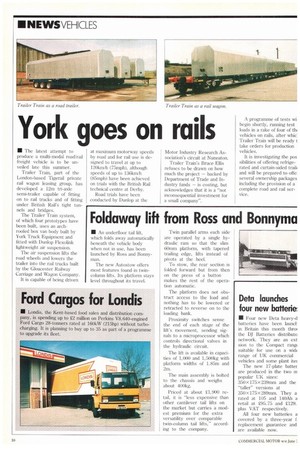York goes on rails
Page 10

If you've noticed an error in this article please click here to report it so we can fix it.
• The latest attempt to produce a multi-modal road/rail freight vehicle is to be unveiled late this summer.
Trailer Train, part of the London-based Tigerail private rail wagon leasing group, has developed a 12m tri-axle semi-trailer capable of fitting on to rail trucks and of fitting under British Rail's tight tunnels and bridges.
The Trailer Train system, of which four prototypes have been built, uses an archroofed box van body built by York Truck Equipment and fitted with Dunlop Flexolink lightweight air suspension.
The air suspension lifts the road wheels and lowers the trailer into the rail trucks built by the Gloucester Railway Carriage and Wagon Company.
It is capable of being driven at maximum motorway speeds by road and for rail use is designed to travel at up to 120km/h (75mph), although speeds of up to 136km/h (85mph) have been achieved on trials with the British Rail technical centre at Derby.
Road trials have been conducted by Dunlop at the Motor Industry Research Association's circuit at Nuneaton.
Trailer Train's Bruce Ellis refuses to be drawn on how much the project — backed by Department of Trade and Industry funds — is costing, but acknowledges that it is a "not inconsequential investment for a small company". A programme of tests wi begin shortly, running test loads in a rake of four of thi vehicles on rails, after whic: Trailer Train will be ready t take orders for production vehicles.
It is investigating the pos sibilities of offering refrigerated and curtain-sided traili and will be prepared to offe: several ownership packages including the provision of a complete road and rail service.




























































